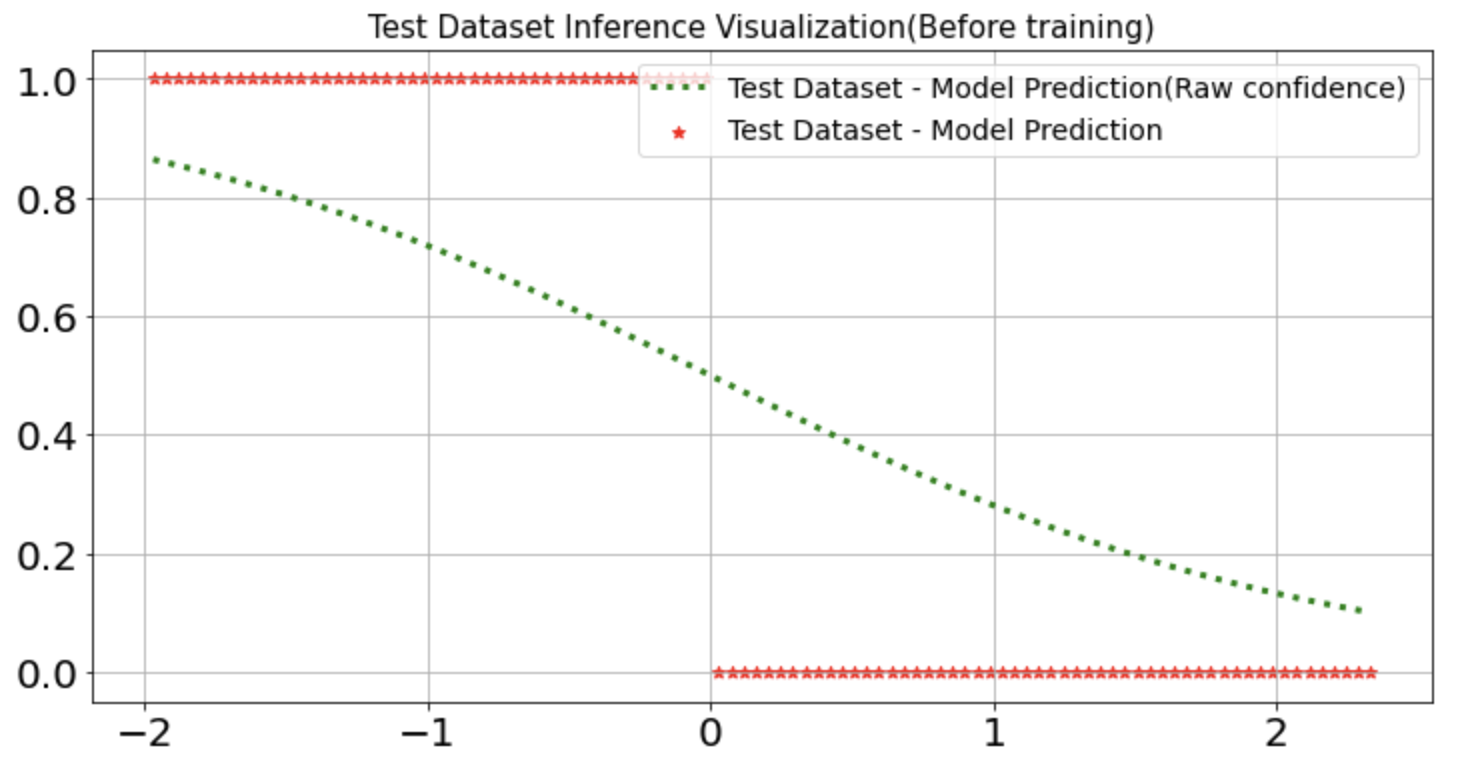[ML] TF Logistic Regression Model Implementation
TF Logistic Regression Model Implementation
- 인프런 - Tensorflow 사용메뉴얼 - Binary Classification, reset_states of Metrics를 수강하고 개인적으로 정리한 내용입니다.
예시코드 및 정리문구는 강의내용 그대로 사용하지않고, 개인적으로 수정한 부분이 있음을 참고하여주시기 바랍니다.
import tensorflow as tf
import numpy as np
import matplotlib.pyplot as plt
# Save GPU memories
physcial_devices = tf.config.list_physical_devices('GPU')
for physical_device in physcial_devices:
tf.config.experimental.set_memory_growth(device=physical_device, enable=True)
SEED = 7777
tf.random.set_seed(SEED)
np.random.seed(SEED)
Create Datasets
# Train Dataset
n_train = 300
train_noise = 0.2 * tf.random.normal(shape=(n_train, 1), dtype=tf.float32)
train_x = tf.random.normal(shape=(n_train, 1), dtype=tf.float32)
train_y = tf.cast(train_x + train_noise >= 0, tf.float32)
# Test Dataset
n_test = 100
x_min, x_max = tf.reduce_min(train_x).numpy(), tf.reduce_max(train_x).numpy()
test_x = np.linspace(x_min, x_max, n_test, dtype=np.float32).reshape(-1, 1)
test_x = tf.convert_to_tensor(test_x, dtype=tf.float32)
# Train Dataset Visualization
fig, ax = plt.subplots(figsize=(12, 6))
ax.set_title('Train dataset', fontdict={'fontsize': 15})
ax.scatter(train_x.numpy(), train_y.numpy(), alpha=0.5)
ax.tick_params(labelsize=20)
ax.grid()

Model Definition
# Model Definition
class BinaryClassifier(tf.keras.Model):
def __init__(self):
super().__init__()
self.d1 = tf.keras.layers.Dense(units=1, activation='sigmoid')
def call(self, x):
preds = self.d1(x)
return preds
model = BinaryClassifier()
Test Dataset Inference Visualization(Before Training)
# Inference(predict x_test)
test_preds = model(test_x)
# Visualize
fig, ax = plt.subplots(figsize=(12, 6))
ax.scatter(test_x, (test_preds.numpy() >= 0.5).astype(np.float32), c='r', marker='*', label='Test Dataset - Model Prediction')
ax.plot(test_x, test_preds.numpy(), 'g:', linewidth=3, label='Test Dataset - Model Prediction(Raw confidence)')
ax.set_title('Test Dataset Inference Visualization(Before training)', fontdict={'fontsize': 15})
ax.legend(fontsize=14)
ax.tick_params(labelsize=20)
ax.grid()

Hyper Parameters, Loss Function, Optimizer
# Hyper Parameters
EPOCHS = 10
LR = 1e-2
# Loss Function
loss_obj = tf.keras.losses.BinaryCrossentropy()
# Optimizer
optimizer = tf.keras.optimizers.SGD(learning_rate=LR)
Training
from termcolor import colored
# tf.data
train_ds = tf.data.Dataset.from_tensor_slices((train_x, train_y))
train_ds = train_ds.shuffle(n_train).batch(8)
# Metrics
loss_metric = tf.keras.metrics.Mean()
acc_metric = tf.keras.metrics.BinaryAccuracy()
for epoch in range(1, EPOCHS+1):
for x, y in train_ds:
# Forward Propagation
with tf.GradientTape() as tape:
preds = model(x)
loss = loss_obj(y, preds)
# Back Propagation
grads = tape.gradient(loss, model.trainable_variables)
# Update Parameters
optimizer.apply_gradients(zip(grads, model.trainable_variables))
loss_metric(loss)
acc_metric(y, preds)
print(colored('Epoch: ', 'cyan'), epoch)
template = 'Train Loss: {:.4f}\t Train Accuracy: {:.2f}%'
epoch_loss = loss_metric.result()
epoch_acc = acc_metric.result()
print(template.format(epoch_loss, epoch_acc*100))
loss_metric.reset_states()
acc_metric.reset_states()
Epoch: 1
Train Loss: 1.0673 Train Accuracy: 8.33%
Epoch: 2
Train Loss: 0.9715 Train Accuracy: 8.33%
Epoch: 3
Train Loss: 0.8852 Train Accuracy: 8.00%
Epoch: 4
Train Loss: 0.8124 Train Accuracy: 8.33%
Epoch: 5
Train Loss: 0.7502 Train Accuracy: 8.33%
Epoch: 6
Train Loss: 0.6974 Train Accuracy: 40.33%
Epoch: 7
Train Loss: 0.6524 Train Accuracy: 91.67%
Epoch: 8
Train Loss: 0.6135 Train Accuracy: 91.67%
Epoch: 9
Train Loss: 0.5803 Train Accuracy: 91.67%
Epoch: 10
Train Loss: 0.5508 Train Accuracy: 91.67%
Test Dataset Inference Visualization(After Training)
# Inference(predict x_test)
test_preds = model(test_x)
# Visualize
fig, ax = plt.subplots(figsize=(12, 6))
ax.scatter(test_x, (test_preds.numpy() >= 0.5).astype(np.float32), c='r', marker='*', label='Test Dataset - Model Prediction')
ax.plot(test_x, test_preds.numpy(), 'g:', linewidth=3, label='Test Dataset - Model Prediction(Raw confidence)')
ax.set_title('Test Dataset Inference Visualization(After training)', fontdict={'fontsize': 15})
ax.legend(fontsize=14)
ax.tick_params(labelsize=20)
ax.grid()

Train Dataset을 학습하여
Train Dataset의 패턴과 유사하게 추론하고 있음을 확인할 수 있다.

Leave a comment